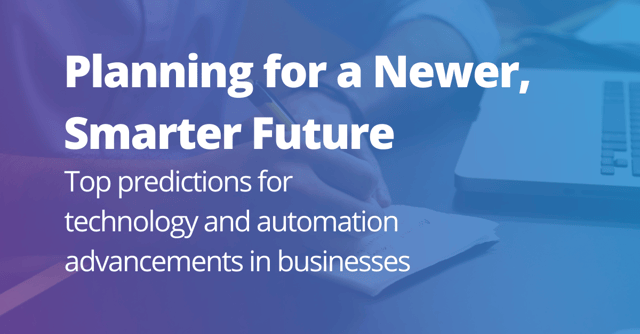Planning for a Newer, Smarter Future
The past year has revealed many truths about the current state of the workplace. Businesses were forced to address outdated and inefficient processes. Entire companies transitioned to remote work, seemingly overnight, and the landscape of the workforce was redesigned in front of our eyes. For a variety of reasons, many employees decided to scale back to part-time work, or entirely abandon their careers. At the same time, consumers of both products and technology, confined to their home, had increased needs.
With demand at an all-time high across all industries, and employees leaving in droves, companies had to rethink their strategy in order to avoid a bottleneck situation. Meeting tight deadlines with a limited staff meant streamlining tasks and automating basic functions whenever possible. As we look forward to 2022, it is evident that many of these changes which occurred throughout the pandemic are here to stay, and companies will need to adapt in order to progress.
Read on to learn about our top predictions for businesses to consider when planning for success this year.
1. Buy now, pay later (BNPL) will become commonplace for businesses.
BNPL options, initially developed with the consumer in mind, will expand to include business-to-business (B2B) customers. In contrast to buying on credit, BNPL allows companies to schedule payments over time with no added fees, making financial planning more streamlined. BNPL eliminates the cost and variable of interest, and can be handled entirely by technology freeing up staff for more high-level work.
If you're interested in learning more about smart payment options, check out Auditoria SmartPay.
2. Strategy planning is no longer reserved for top-level executives.
Historically, junior-level accounting professionals occupied the majority of their time with more administrative work. This practice is a drain on companies – it wastes both money and talent on projects that can easily be handled by technology. With the rise of AI, businesses will have the ability to automate daily tasks, freeing up staff members for more strategic work.
Retention will improve when all members of the company feel more involved and are appropriately utilized. AI is a much more cost-effective approach to low-level tasks – technology can complete projects faster and more accurately than a human can, and the hourly rate is often much more attractive. Hiring is a challenge right now and that probably won’t change, maximizing your current roster is in your best interest.
3. Emails will be handled by robots.
Everyone has experienced a conversation with AI through either a chatbot on a company website or an automated email response. We are already surrounded by AI and the future will see an increase in this technology. Shared company email accounts, often managed by staff members in addition to their own inbox, can instead be directed to robots.
Inquiries from outside vendors and customers requesting product information or payments can be handled by AI programmed to respond seamlessly and accurately. This transition will save both time and money, while also creating uniformity in responses and eliminating the chance of human error.
4. Automation reduces days sales outstanding (DSO) freeing up cash flow.
Cash fuels business, without cash flow it is impossible to purchase products, pay staff, pay rent and continue to keep a company operating. DSO is a major culprit of debt and can be a headache to manage. Accounts receivable staff must pull records, analyze data, and calculate the cost of outstanding payments in order to prioritize collection efforts.
Automation of accounts receivable allows technology to analyze data instantly providing real-time results for a more focused effort to quickly track down payments. This targeted approach to reducing DSO frees up cash flow to be reinvested in the business reducing the need for excess and costly outside capital.
5. The impact of COVID-19 is permanent.
The pandemic catapulted the world of technology ahead at lightning speed. Businesses unequipped for remote work had to transform in mere days. Ecommerce and logistics demands gained traction at warp speed. Entry-level jobs were viewed by employees as no longer worth their time (or risk) and were abandoned. Companies were left with an abbreviated staff, scattered geographically, and simultaneously a surge in demand for goods and services.
The world of technology experienced a major advancement in a short amount of time and while we may not have been ready – there was no alternative. As we settle into this “new normal” it is evident that these changes are here to stay, and the ripple effect of the past two years shows no end in sight. The digital evolution of the pandemic has been beneficial - more companies are embracing technology to automate processes allowing them to survive with a smaller staff and optimizing the quality of work.
What 2022 holds
The new year awards us time to reflect and recalibrate on our past successes and the areas where we can improve. This year piggybacked the year before as we work to accept our new reality. All of the changes that occurred in 2020 seemed temporary, and 2021 taught us that they are here to stay.
Technology must be embraced. It enhances the workflow and promotes employees to more focused and important tasks. Automation reduces error and creates consistency. Technology doesn’t discriminate – it handles the most menial tasks with high-quality results. This year companies should focus on supporting their employees and customers while reducing costs through the adoption of AI, particularly in the area of accounts receivable which is often neglected when it comes to advancement.
Let’s change the narrative – “if it ain't broken, try something new anyway!”

